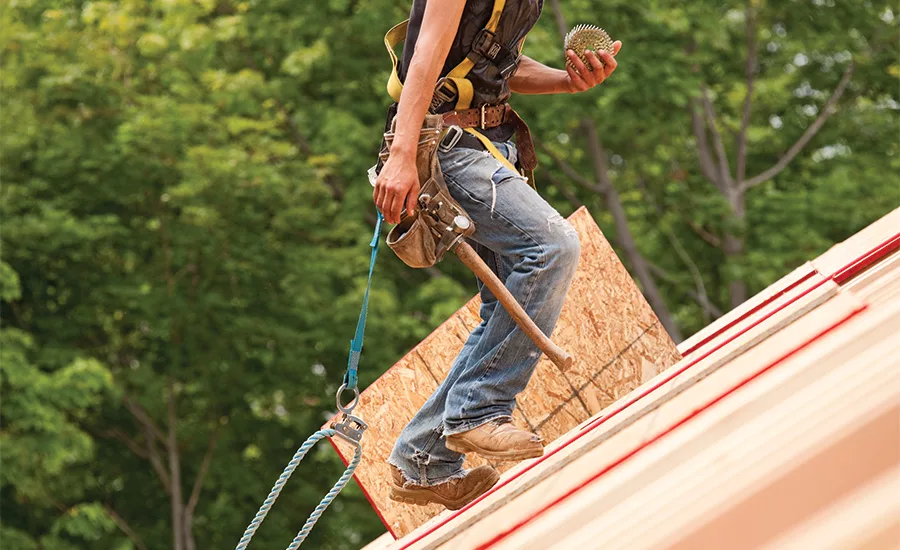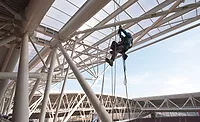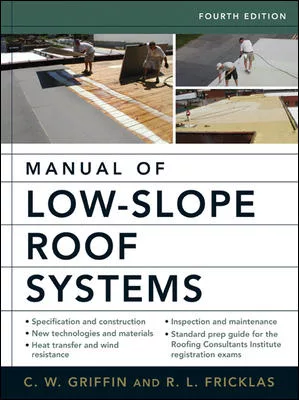Tool Belts and Harnesses: Over, Under or Integral?
Roofing contractors must carefully consider how to use a harness and tool belt together in order to exhibit a good-faith effort to eliminate or mitigate infeasibility and greater fall hazards.

Except for the roofing inspector, most roofing contractors would expect their employees to wear a tool belt while on the roof deck.
In most cases, these same individuals would also be required to wear a full body harness (FBH) to comply with OSHA’s 29CFR, §1926.502(d), in lieu of any other compliant fall protection/prevention methods (I.E. safety nets, guardrail systems, etc.). Ironworkers, scaffold installers and other elevated trades (those working at trigger heights of 15 feet, 10 feet or 6 feet above a lower level) would also be included in this employee group.
There are no specific OSHA Standard Regulations or ANSI-recommended guidelines regarding harnesses worn in combination with a tool belt. However, the roofing contractor must carefully consider them both in order to exhibit a good-faith effort to eliminate or mitigate infeasibility and greater hazards under the General Duty Clause 5(a)(1) of the OSH Act.
It may be feasible to wear a fully-loaded tool belt and an FBH simultaneously, but depending on precisely how they are both chosen and used, it may actually pose a greater hazard to the worker by interfering with the function of his or her personal fall arrest systems (PFAS) or impede the roofer, making roofing tasks infeasible.
Tool Belt Over Harness
The technique of wearing a tool belt on top of an FBH is commonly observed on residential roof jobs in my area of upstate New York and New England, where PFAS are also being implemented. At first glance, it appears to be a convenient equipment donning method, enabling the roofer to efficiently reach tools and fasteners while struggling to be compliant with OSHA’s Subpart M when used “as part of a complete personal fall arrest system which maintains a safety factor of at least two.” But on closer inspection, it remains a dubious point of contention whether this method is, in fact, in strict compliance with OSHA’s 5(a)(1) General Duty Clause.
Is the employer who allows this practice actually providing a place of employment “free from recognized hazards that are causing or are likely to cause death or serious physical harm to his employees?” Is this ensemble actually providing conditions that are conducive to the worker’s health and safety should that roofer experience an arrested fall?
The fall protection-compliant roofers that I’ve interviewed state that, while their employer provides them with an FBH as part of their PFAS, they’re generally expected to bring their own personal tools to the job.
There are two basic styles of FBH on the market today:
1) “H” Style (also known as vest-type): The anterior (front) webbing of the vertical shoulder straps and the horizontal chest strap form the letter “H.” This harness style commonly employs a waist belt as well. It is donned like a vest — one arm at a time — after which the sides of the vest and leg straps are buckled.
2) “X” Style (also known as cross-chest): The anterior webbing of the shoulder straps are stitched together as they cross over each other just below the sternum, forming the letter “X.” This harness style typically does not have an integral waist belt. The worker usually steps into both leg strap loops, then the upper webs are slipped over the head and shoulders and buckles are tightened.
Most veteran roofers have worn their favorite tool belt configuration (tool holders and pouches) for their entire career, and only recently (if ever) began donning an FBH in a complete fall arrest system. The typical opinion I’ve encountered among roofers was that this was a “trade-accepted method” of compliance and OSHA “should just get over it.”
The problem with this arrangement has to do with Newton’s Third Law of Motion: “For every action there is an equal and opposite reaction.”
When a 200 lb. worker, wearing an FBH experiences a 6-foot freefall, they accelerate under the influence of gravity (1 G). At the end of his or her freefall (3 feet with a roofer’s lanyard) the accumulating energy is transferred to a shock-absorber pack attached to the harness’ dorsal D-ring between the shoulder blades. Here, the energy is directed to the deceleration device at the upper end of the lanyard.
The webbing folded inside the elongation package is stitched with threads requiring 400 lbs. of force to initiate breaking and 900 lbs. of force to continue breaking. This is an inverse proportion of tensile strength versus applied energy. The longer a person falls, more energy is required to break the threads while the energy of deceleration is diminished over several seconds. This results in a terminal impact force (TIF) of 1,800 lbs. or less. This is comparable to the force of a seatbelt on your body if your vehicle struck a solid, backfilled concrete retaining wall at 15 mph.
In order to achieve this minimal TIF, all of the components of your PFAS must work as designed — without damage or restrictions — for the energy generated from acceleration and deceleration to be abated and prevent injury to the fall victim. When rigging a load with synthetic web slings, the rigging becomes a machine with moving parts (fibers) designed to move over each other with minimum resistance (friction). Similarly, when the nylon fibers in the harness webbing elongate during fall arrest, they become individually narrower in cross section. Simultaneously, each fiber is compressed against their neighbors in the weave, making the webbing stronger than its parts.
An arrested fall is a kinetic event that rapidly and violently affects every harness component. Any restriction or deflection of the vertical material components by an overlaid tool belt could affect their ability to handle the applied stresses as designed. Accumulating forces may be multiplied at this crossover point beyond the tensile strength of the synthetic material of the harness, potentially causing it to either fail or become internally damaged. More importantly, if restricted, the harness may not function optimally as designed, resulting in a higher TIF than the manufacturer specified and OSHA/ANSI allows.
Harness Over Tool Belt
Total compliance with OSHA’s Subpart M aside, we can probably agree that in a harness-over-belt design, the issue of equipment compatibility is, at best, problematic. If the worker chooses to wear his/her tool belt underneath the harness, there are FBH designs that are significantly more practical and effective than others. Of course, this depends on the attachment configurations between the vertical shoulder straps and the leg strap engaging the pelvic girdle of the roofer.
While this method of installing the tool belt prior to donning a harness over it may mitigate any “greater-hazard” issues, it may lead to subsequent feasibility issues as well.
In my experience, no two construction workers ever wear identical tool belts. Some roofers may prefer belts with pouches and tool holders permanently installed on the belt with rivets or stitches. Some prefer heavier, deeper pouches worn in reverse while working on a ladder. Others might want more versatility by hanging these items with loops independently from a waist belt in order to adjust them for personal convenience and comfort. However, in this arrangement of harness-over-belt, the arrangement of various pouches and tool holders should be fully adjustable on a separate leather or synthetic web tool belt. This method would abate any contact with the exterior vertical crossover webbing of the harness as they form the leg straps located below the belt line and just above the hips.
An “X” style harness is recommended, preferably with just one dorsal D-ring and unadorned with a waist belt or any additional equipment or attachments. Keeping the harness as simple as possible will reduce the number of webbing straps, helping to avoid tool belt conflicts and ultimately reduce costs.
As nail and utility pouches, hammer loops, screw gun holsters and tape holders may slide on the belt underneath the harness, they can be positioned according to the roofer’s preference without conflicting with the right and left harness shoulder straps. This might take some getting used to, as roofers commonly choose to position the heavier hammer/nail gun holster and nail pouch over the right and/or left hip.
This arrangement of equipment will eliminate any restraints or impingements of the harness webbing during a fall arrest event, allowing the force magnitude during deceleration to travel unencumbered along the designed vectors to the pelvic girdle.
Every PFAS component is expected to absorb its share of the TIF until the victim is finally arrested and suspended in net-zero energy. As deceleration occurs you may experience an initial slam (1,800 lbs.) followed by multiple and diminished rebounds between periods of zero gravity. Loose materials in pouches and tools in holders may be forced totally or partially out of your tool belt at terminal impact, possibly becoming falling or impaling objects. Tethering your tools and covering your pouches are only common sense for roofers to prevent falling objects, especially on steep roofs.
Harness-Integrated Tool Belt
In the past several decades, most PFAS manufacturers have come to understand this compliance problem for the at-height building trades. Most have designed integrated solutions to meet the conflicting needs of fall protection and standard construction practices.
Many of these solutions are innovated and simple. As most of the “H” harnesses and some of the “X” harnesses now incorporate an integrated tongue-and-buckle waist belt in their design, why not make it removable, allowing the user to install after-market pouches and miscellaneous tool hangers as the worker desires? Some manufacturers have gone even further, incorporating their own tool belt designs with Velcro covers on pouches along with tethers on tool holders.
With this one piece harness-tool belt ensemble, the webbing components are typically oversized and designed to travel unencumbered over the tool belt in pass-through loops, while the waist buckle provides a structural lateral tie-in to keep components properly aligned during an arrested fall.
The least expensive, simple “X” style harness runs about $75 while an “H” harness with a padded, integrated tool belt and miscellaneous accessories can cost four times that amount. A mid-range harness with a removable belt to hold your pouches can provide a cost-effective compromise. The contractor who has professional concerns about PFAS for workers on roofs certainly realizes that nothing effective is ever simple, quick or cheap. I find that stubbornness is more often an asset than a detriment for any corporate safety director.
The fact of the matter is, roofers rarely contemplate their potential fall and fewer are prepared for it. Ask those who have fallen off of a roof while implementing PFAS, and most will tell you they were wearing their standard tool belt over the straps of their harness. At best, most admit it wasn’t a pleasant experience, as the arrest was a chaotic shock and the suspension extremely uncomfortable. Even minor to moderate injuries can inhibit the ability to self-rescue and contribute further to lost work time.
While I have not encountered any deaths or life-threatening injuries due to this practice, it would still seem prudent to avoid any potential, as most post-arrest suspension periods are prolonged while waiting to be rescued by coworkers who have never even practiced the operation.
Realistically, most of the veteran roofers that I know are reluctant to change long entrenched behaviors. However, competently training apprentices and new hires in mandatory personal fall arrest practices while wearing employer-required, belt-integrated harnesses may prove more successful for the roofing contractor to accomplish. By attrition, that contractor’s workforce will eventually don more compliant equipment and consistently use them safely.
Of course, we should all prepare for the more experienced roofers to contend: “I’ve been working like this for years and never had a roof fall! I sure don’t plan on having one now.”
Looking for a reprint of this article?
From high-res PDFs to custom plaques, order your copy today!






